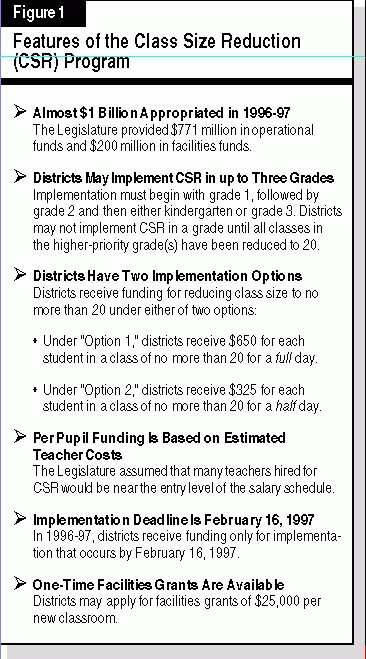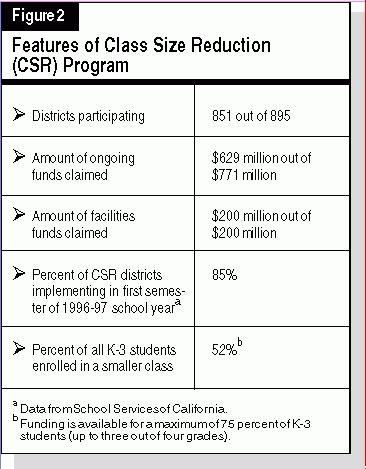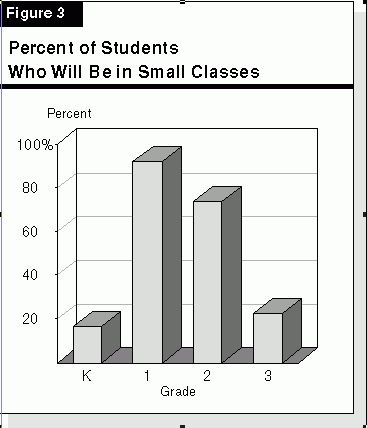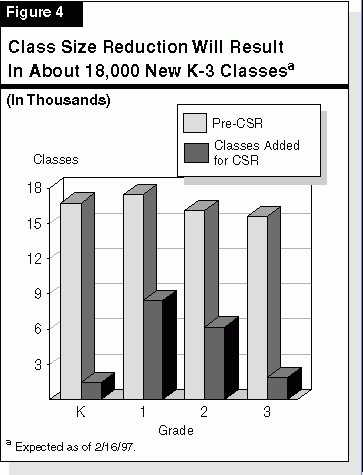

The Legislature and the Governor created the Class Size Reduction (CSR) program as part of the 1996-97 Budget Act. The program is intended to increase educational achievement by reducing statewide average class size from 28.5 to no more than 20 in up to three grades from kindergarten through third. Figure 1 summarizes the provisions of the CSR program.

Most school districts elected to participate in the program. Of the 895 school districts eligible for the CSR program, 95 percent, or 845 districts, elected to participate. Of the participating districts, about 85 percent began reducing class sizes at the beginning of the school year. All participating districts must complete implementation of the program by February 1997. Figure 2 summarizes district participation and funding.

As Figure 2 shows, districts expect to claim $629 million, or 82 percent, of the funding appropriated for CSR. Of districts implementing CSR, fewer than 2 percent have chosen Option 2 in grades 1 through 3. In kindergarten, 20 percent of implementation has occurred under Option 2. Thus, the use of Option 2 is substantially lower than the 25 percent anticipated in the budget.
Figure 2 also shows that 52 percent of the state's K-3 students are expected to be in small classes this year. District implementation of CSR focused on grades 1 and 2, as shown in Figure 3. Ninety-two percent of the state's grade 1 students and 74 percent of grade 2 students will be in small classes by the implementation deadline of February 16, 1997. Implementation in kindergarten and grade 3 is significantly less common.

One-time funds for facilities have been insufficient to meet demand. As Figure 2 shows, the entire $200 million appropriation in the 1996-97 Budget Act was distributed to schools. The State Department of Education received 14,000 requests for facilities grants to implement the CSR Program. Available one-time funds will cover 8,000 of these requests. The Superintendent of Public Instruction and the Governor have advocated using unspent 1996-97 CSR operational funds to provide additional facilities grants.
Figure 4 shows the existing number of K-3 classes in the state in 1995-96 and the number of new classes that will be created by CSR in 1996-97. Overall, CSR will add about 18,000 new K-3 classes in the state, an increase of 21 percent. The statewide average class size in kindergarten through grade 3 was about 28.5 in 1995-96. We estimate that K-3 class size will average about 23.5 by the end of the 1996-97 school year.

Few Districts Are Using Option 2. In providing $771 million per year for CSR operating costs, the Legislature believed it was providing sufficient funds to implement CSR statewide in three grades. However, this figure assumed that 25 percent of CSR classes would be under Option 2which provides half the per-student funding ($325) for a half day of smaller class size. In fact, only 3 percent of CSR implementation in 1996-97 is under Option 2. Assuming (a) current trends in use of Option 2 continue and (b) current per-student funding levels for both options, the CSR program will actually cost about $880 million per year for full implementation in three grades, or an additional $110 million.
Adequacy of Per-Pupil Funding Is Uncertain. The $650 per-pupil incentive funding provided by the Legislature for CSR may not be sufficient to fund the costs of the program in some districts, while others will find that CSR funding exceeds their costs. Some districts argue that the Legislature should fund all additional costs of the program. Thus, the Legislature will have to determine whether additional CSR funds are needed and, if so, whether these funds should be targeted for CSR by the state or provided to districts to spend at their discretion.
Shortages of Facilities Funds. The one-time funds set aside by the Legislature will provide 8,000 facilities grants out of 14,000 requests. These grants generally cover only about half the cost of portable classrooms. Some districts argue that lack of funds earmarked for facilities hamper their ability to implement CSR.
Anecdotal Reports of New Potential Issues. Both anecdotal and newspaper reports suggest a number of issues at both the state and local level. Some districts report:
Contact -- Joel Schwartz -- (916) 445-8641
Recent reports continue to indicate that California's economy is expanding at a healthy pace in the second half of 1996. Based on recently-released interim benchmark revisions, it appears that wage and salary employment in October was up by nearly 400,000 jobs from the prior yeara gain of 3.4 percent. In other developments, permits for new residential construction exceeded 105,000 units (seasonally adjusted annual rate) in both September and October, providing some evidence that real estate construction activity is finally beginning to improve.
On a less positive note, taxable sales growth moderated during the third quarter of 1996. Based on preliminary data, sales were up 5.6 percent during the July through September period from the prior year, which is significantly less than the over 8 percent increase experienced during the first two quarters of 1996. The near-term outlook for sales remains positive, however, given the continuing gains in employment and income, as well as the improvement in home construction during recent months.
Contact -- Brad Williams -- (916) 324-4942
California Update is published monthly -- except January and February -- by the Legislative Analyst's Office (LAO).
The LAO is a nonpartisan office which provides fiscal and policy information and advice to the Legislature.
Reports are also available on the LAO's World Wide Web page at http://www.lao.ca.gov. The Legislative Analyst's Office is located at 925 L Street, Suite 1000, Sacramento, CA 95814. |